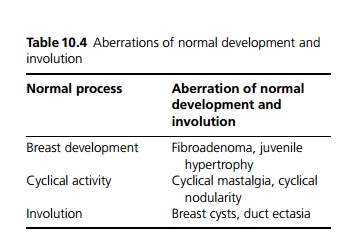Chapter: Medicine and surgery: Breast disorders
Benign breast disease - Benign disorders of the breast
Benign disorders of the breast
Benign breast disease
Definition
Abnormalities that occur during the normal cycle of breast proliferation and involution. Previously known under various names (fibroadenosis, fibrocystic change, mammary dysplasia) these have now been classified as aberrations of normal development and involution (ANDI) (see Table 10.4).

Incidence
Common, affecting most women to some extent.
Age
From puberty onwards, peaks in later reproductive life, declines after menopause.
Aetiology
Benign breast disease is thought to occur due to an abnormal tissue response to hormones.
Clinical features and investigations
Some women develop generalised breast nodularity and others present with more localised nodularity (see also section Breast Lumps, page 409). If excised most areas of nodularity show either no abnormality or aberrations of the normal involutional process such as focal areas of fibrosis or sclerosis. Triple assessment (clinical examination, imaging and tissue sampling) is required for any new discrete lump, a new lump within preexisting nodularity or asymmetrical nodularity that persists after menstruation.
Management
For management of specific forms of ANDI see individual conditions.
Related Topics